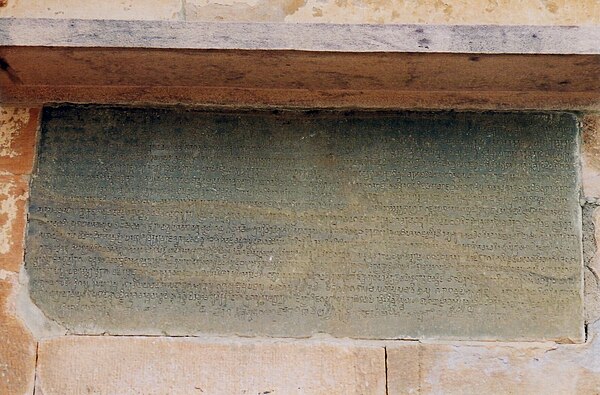Pulakeshin II
Videos
Page
Pulakeshin II popularly known as Immaḍi Pulakeśi, was the greatest Chalukyan Emperor who reigned from Vatapi. During his reign, the Chalukya Empire expanded to cover most of the Deccan region in peninsular India.

"The defeat of Pulakeshin II, the Chalukya, by Mahamalla Pallava at Badami", an artistic depiction of Pulakeshin's defeat

Original frescoes in Ajanta Cave 1, and corresponding artistic depiction of Pulakeshin receiving envoys from Persia. Earlier scholars believed that Pulakeshin received an envoy from the Sasanian emperor of Persia, based on the Ajanta cave painting, but this theory is no longer considered correct.

The Aihole inscription composed by Pulakeshin's court poet Ravikirtti

Painting of Pulakeshin II in Bengaluru
Chalukya dynasty
Videos
Page
The Chalukya dynasty was a Classical Indian dynasty that ruled large parts of southern and central India between the 6th and the 12th centuries. During this period, they ruled as three related yet individual dynasties. The earliest dynasty, known as the "Badami Chalukyas", ruled from Vatapi from the middle of the 6th century. The Badami Chalukyas began to assert their independence at the decline of the Kadamba kingdom of Banavasi and rapidly rose to prominence during the reign of Pulakeshin II. After the death of Pulakeshin II, the Eastern Chalukyas became an independent kingdom in the eastern Deccan. They ruled from Vengi until about the 11th century. In the western Deccan, the rise of the Rashtrakutas in the middle of the 8th century eclipsed the Chalukyas of Badami before being revived by their descendants, the Western Chalukyas, in the late 10th century. These Western Chalukyas ruled from Kalyani until the end of the 12th century.

Old Kannada inscription of Chalukya King Mangalesha dated 578 AD at Badami cave temple no.3

Old Kannada inscription on victory pillar, Virupaksha Temple, Pattadakal, 733–745 AD

Coinage of the Chalukyas of Badami. Uncertain ruler. c. 597–757 AD. Boar and Temple type.

Bhutanatha temple complex, at Badami